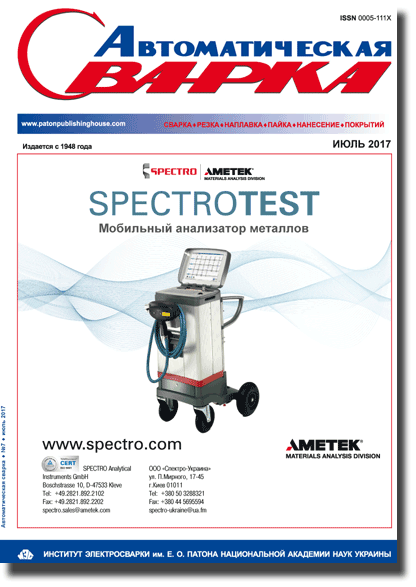| 2017 №07 (07) |
DOI of Article 10.15407/as2017.07.08 |
2017 №07 (09) |

Avtomaticheskaya Svarka (Automatic Welding), #7, 2017, pp. 48-52
Arc surfacing of layers of metal of varying composition and hardness
V.V. Peremitko and A.I. Panfilov
Dnieper State Technical University 2 Dneprostroyevskaya, 51918, Kamenskoye, Ukraine. Е-mail: welding@dstu.dp.ua
Abstract
In arc surfacing over the layer of alloying charge, the conditions for producing layers with varying composition and structure in the zones of separate beads were determined. On the deposited surface the carbon-containing fibres were preliminarily deposited in bands, the width and distance between which were selected from the conditions of positioning the end of the electrode with displacement relative to the edge of the bands. To fix the fibres, a primer was used, into which the iron powder and aerosol SiO2 were added. During the experiments a number of deposited layers, the eccentricity in the arrangement of bands relative to the axis of electrode wire, as well as the induction of external magnetic field were varied. The difference in hardness of the metal across the width of the deposited beads (up to HRC 9–12) and the successively deposited layers (up to HRC 15–25) was established. The hardness reaches its maximum values at the eccentricity c = 4 mm and induction B = 40–80 mT and also at c = 10–12 mm and B up to 40 mT. The increase in hardness is observed with increase in the amount of deposited layers. The metallographic analysis recorded an increase in the fraction of hardening structures (in the form of acicular bainite and martensite) from 15–22 to 25–35 % in the second layer and more than 50 % in the third one 13 Ref., 1 Table, 10 Figures.
Keywords: arc surfacing over alloying charge, deposited metal, hardness, microstructure of deposited metal, controlling magnetic field, carbon-containing fibre
Received: 16.04.17
Published: 01.09.17
References
- Garkunov, D.N. (1989) Tribo-engineering. Moscow: Mashinostroenie.
- Kostetsky, B.I. (1975) Reliability and service life of machines. Kiev: Tekhnika.
- Kragelsky, I.V., Dobychin, M.N., Kombalov, V.S. (1977) Calculation principles on friction and wear. Moscow: Mashinostroenie.
- Vlasov, V.M. (1987) Working capacity of strengthened rubbing surfaces. Moscow: Mashinostroenie.
- Frumin, I.I. (1961) Automatic electric arc surfacing. Kharkov: Metallurgizdat.
- Tylkin, M.A. (1971) Improvement of life of metallurgical equipment parts. Moscow: Metallurgiya.
- Ryabtsev, I.A., Kondratiev, I.A. (1999) Mechanized electric arc surfacing of metallurgical equipment parts. Kiev: Ekotekhnologiya.
- Leshchinsky, L.K., Gulakov, S.V., Stepnov, K.K. et al. (1985) New design rolls with deposited layer increase operating efficiency of mills. In: Experience and efficiency of application. Kiev: PWI, 17–20.
- Gulakov, S.V., Golovachev, M.V., Alengos, N.N. (1990) Automated equipment for arc surfacing of working layer with regulated distribution of properties. In: Equipment and materials for surfacing. Kiev: PWI, 14–17.
- Sokolov, G.N., Lysak, V.I. (2005) Surfacing of wear-resistant alloys on press dies and tool for hot deforming of steels. Volgograd: RPK Politekhnik.
- Savulyak, V.I., Zabolotny, S.A., Shenfeld, V.I. (2010) Surfacing of high-carbon coatings using the carbon fibers. Problemy Trybologii, 1, 66–70.
- Peremitko, V.V. (2014) Wear-resistant arc surfacing over the layer of alloying charge. The Paton Welding J., 8, 54–57. https://doi.org/10.15407/tpwj2014.08.09
- Peremitko, V.V., Nosov, D.G. (2015) Optimization of modes of submerged arc surfacing over the layer of alloying charge of caterpillar machine running gear parts. Ibid., 5/6, 44–46. https://doi.org/10.15407/tpwj2015.06.10
The cost of subscription/purchase order journals or individual articles
| Journal/Currency | Annual Set | 1 issue printed |
1 issue |
one article |
| TPWJ/USD | 384 $ | 32 $ | 26 $ | 13 $ |
| TPWJ/EUR | 348 € | 29 € | 24 € | 12 € |
| TPWJ/UAH | 7200 UAH | 600 UAH | 600 UAH | 280 UAH |
| AS/UAH | 1800 UAH | 300 UAH | 300 UAH | 150 UAH |
| AS/USD | 192 $ | 32 $ | 26 $ | 13 $ |
| AS/EUR | 180 € | 30 € | 25 € | 12 € |
| SEM/UAH | 1200 UAH | 300 UAH | 300 UAH | 150 UAH |
| SEM/USD | 128 $ | 32 $ | 26 $ | 13 $ |
| SEM/EUR | 120 € | 30 € | 25 € | 12 € |
| TDNK/UAH | 1200 UAH | 300 UAH | 300 UAH | 150 UAH |
| TDNK/USD | 128 $ | 32 $ | 26 $ | 13 $ |
| TDNK/EUR | 120 € | 30 € | 25 € | 15 € |
AS = «Automatic Welding» - 6 issues per year;
TPWJ = «PATON WELDING JOURNAL» - 12 issues per year;
SEM = «Electrometallurgy Today» - 4 issues per year;
TDNK = «Technical Diagnostics and Non-Destructive Testing» - 4 issues per year.





